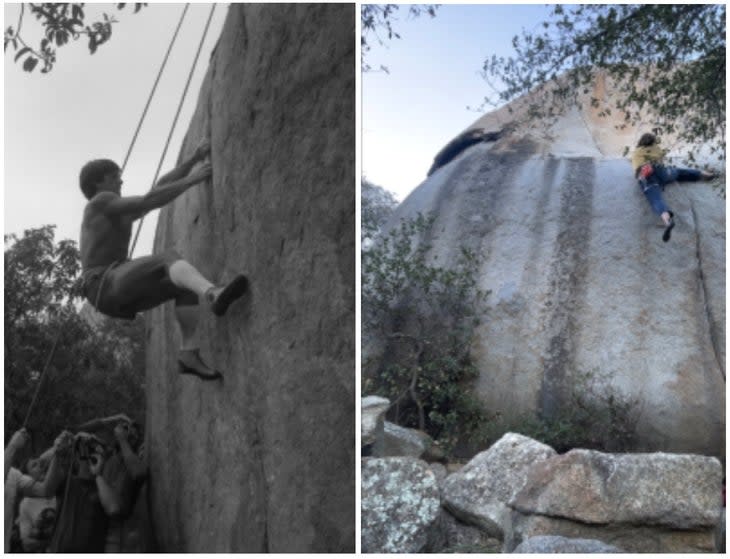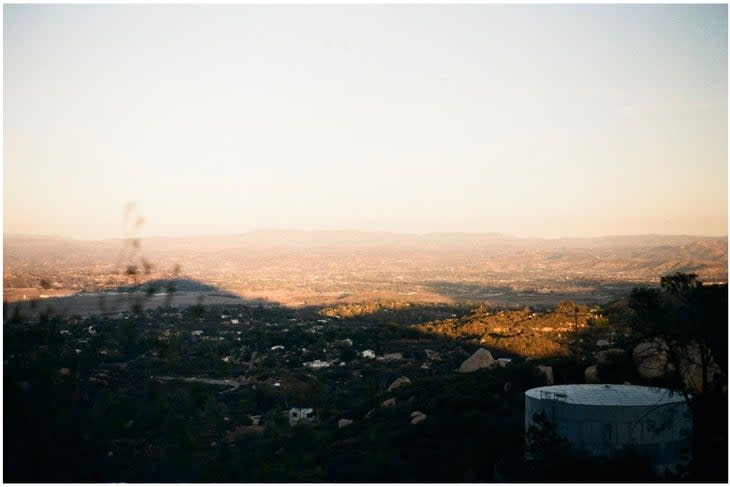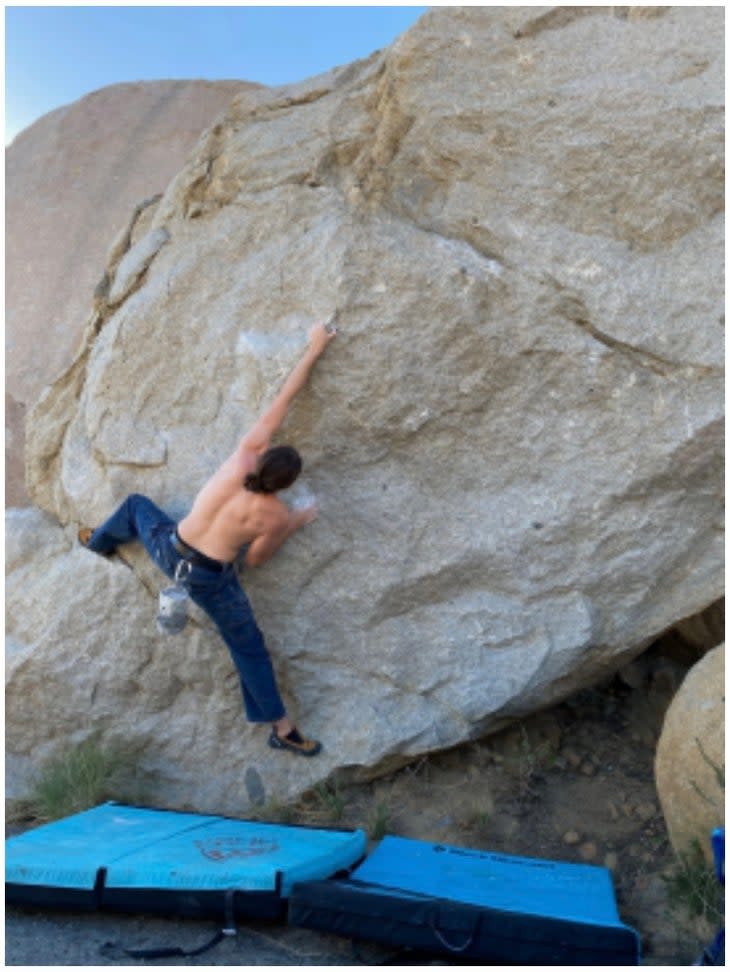Why Mount Woodson is a Cult-Classic Crag
This article originally appeared on Climbing
With two fingers locked into a half-inch crack I stared up at the bulge, over which I knew the next jam cruelly waited. My knuckles were going to pop out of my fingers, and I was close to tears, only two feet up Lie Detector (5.12a). Ron Kauk made it look so easy--in his calf socks and short shorts. Fuck it, I thought, and pulled on gear.
What would Ron Kauk think, I would wonder later, staring at pictures of the legend competing in a 1992 Woodson Climbing Competition organized by Carmel Schimmel and former Climbing magazine correspondent Ron Amick. Nevermind that I had climbed the rest of the crack free, I had sought history, I had found it and failed to relive it. Such is the life of a Mount Woodson climber, though. The area is a land of hope, frothing attacks on uncaring granite, and crushing defeat. If this doesn't sound like fun to you, it probably isn't.

Later, while interviewing Amick about Woodson, I would learn Kauk's own competition send was under some slight dispute: "Kauk came to the competition a day early and went climbing with Carmel and Rick Piggot. Word is that they climbed some of the things that would be in the contest the next day," he told me. Unfortunately for my ego, even this minor ascent of Kauk's remains unassailable since Amick "believes that Kauk would have won no matter what." The bastard.
Since moving to San Diego California to go to college, Mount Woodson has quickly become my local ego-shattering crag. Woodson itself is small, aptly described by the late legend Bob Van Belle in his 1989 Climbing article as a land of "premium miniatures." Nestled into the scrubby, dusty, desert chaparral of San Diego County, Woodson quietly manages to offer some of the best granite crack and face climbing I've ever come across. It isn't a well-kept secret, nor is it out of the way (a paved two-mile hike leads directly to the summit, and areas are all within five minutes of the trail), but through some strange or arcane force, it remains blessedly uncrowded.
Despite this seeming invisibility to passersby, Woodson has a sort of cult history and following. Stonemasters competitions were held here in the eighties, Royal Robbins put up FFAs of various cracks in the area, and such figures as Van Belle, Amick, and a mysterious fellow by the name of Professor Keith Bruekner PhD--who wrote the only known dedicated Mount Woodson guidebook in 1987--frequented the area. Other notable visitors, including Rick Piggot, Randy Leavitt, Jerry Moffat, John Bachar, and Lynn Hill, have lent Woodson a sublime and almost terrifying aura.
Sadly, like other great peoples of history--the Indus valley dwellers, the Rapa Nui, or the Khmer, the original developers of Woodson in the 1960s are, in Belle's words "shrouded in the mists of prehistory." What history is available must be pieced together from what tidbits and shreds of information remain. Mountain Project stories, old documents, and doubtful if not apocryphal sixth-hand accounts from scruffy climbers must be relied on with a heavy grain of salt. Few true first-person sources of information exist, apart from Ron Amick himself, who was a well-spring of knowledge, but lamented "I have morphed into the resident historian for Woodson over the years, kinda by default because none of my contemporaries are interested in Woodson anymore. I’m 67 and when I’m gone a lot of Woodson lore will go with me."

In the 1970's a group of climbers called the Poway Mountain Boys--named for the city of Poway, which Woodson overlooks--began developing the crack climbs of the area. This group included Rick Piggot and Greg Cameron, who would lead the Boys to push the grade ceiling of the time, climbing 5.11+ cracks in the area and putting up hard ascents in Yosemite. Royal Robbins once visited Mount Woodson with Piggot, and, after being shown a crack the Poway Mountain Boys had climbed on aid, quickly proceeded to free climb it at 5.10a, dubbing it Robbins Crack.
Woodson, more than anywhere else I've climbed, adheres to a finger-mangling sandbagging tradition. Belle described it as a "perennial problem peculiar to Woodson: the combination of brevity and difficulty [which] often elicits unrealistic ratings by locals." Climbs in Woodson are typically short--just 10 moves, or 25 feet--pumpy, and immaculate, although even the best cracks are rarely led. Top rope bolts are common on anything above 15 feet and almost guaranteed if it's above 20, which, as always, leads to bolt fuckery and sabotage. Climbs like Alcoa (5.11c) have been TR bolted, chopped poorly, and rebolted. Comedic and heated debates about the ethics of bolting Woodson routes can be found in spades on Mountain Project.
Ron Amick said when I interviewed him, "We considered Woodson to be a bastion of traditional ethics, and we took action to keep it that way. The routes are mostly short so bolts were frowned upon (except for anchors) and had to be placed on lead."
Adam Stackhouse, a Mountain Project administrator and Woodson local, has bolted many a Woodson route and is a self described "proud owner of a Bosch Bulldog." Stackhouse takes the stance that, because Woodson is so predominantly top-rope bolted, there shouldn't be any problem bolting something that could be protected traditionally. The hardman ethic Amick espouses has a certain romantic allure to me, but because Woodson is such a uniquely accessible area that is so perfectly suited to new climbers, I tend towards Stackhouse's more contemporary views. The archival record too seems to back up his claim, since Lynn Hill top-roped the John Bachar classic Driving South (5.11c). The Stone Masters Competition 1986, too, was all done on top rope; the promotional flier says, "There will be mandatory top ropes on all routes."
Woodson climbers also differed on "cleaning" methods. While revolutionary off-width techniques were being put to use by area legends like Piggot in acts of traditional hard-climbing insanity, actions which would make even the most contemporary of climbers now weep or vomit were also being carried out. Climbs like the classic crack The Widow Bereft (5.12a) were "entirely manufactured" down to boulders being moved by car jacks. Whether or not climbers now are aware of the sins of our fathers is unclear. The act of creation which exists in The Widow Bereft is just a small sample of the surreal human presence in Woodson. Other perfect lines like Ph.D (5.12a) have drilled monos, and several boulders go by the ominous name of Blasted Rock #1-3.

Mountain Project is the best place for climbers to look for area information. (If you're a collector of disappearing guidebooks with ninety dollars to spare, there are a few copies of the San Diego County Climbing Guide by Dave Kennedy and Chris Hubbard floating around on the internet.) Stackhouse sees his role in the site as much historian as moderator. "Historical interest is very fluid among Admins," he says, "I hold the position that it is strongly important. Mountain Project is the largest repository of rock climbing information." By all accounts, Stackhouse has done an excellent job: a few historical pictures and nuggets of Woodson’s past may be found on Mountain Project, in addition to route beta.
Van Belle finishes his article off claiming that "Woodson's greatest significance lies in its past ... [as] a contemporary virtuoso seeking insight into the standards and accomplishments of yesterday's hardmen." In some ways that is true; Woodson's greatest years of hard first ascents and terrifying solos are likely behind it. But the glory of a place resides as much in its beauty and the joy of current climbers as it does in its past--the sensation of standing next to giants as you stare in awe at a finger shredding crack disappears the minute you jam your poor unsuspecting fingers in there and pull up. History remains only as long as your knuckle skin does.
Plan Your Trip:
When: Spring and fall are ideal since it remains fairly temperate and not too sunny. Winter works too, but the possibility of rain (and sometimes hail) is higher. Summer is more of a bit of no-go since the sun is relentless and the approach doesn't have much shade.
Where to stay: Woodson is located oddly close to San Diego proper, so any number of motels to high class resorts are available to you southwest of the park. But if you're interested in camping or just a fellow dirtbag living out of your car, Culp Valley, about the same distance east of Woodson as San Diego is west, offers free camping, quality bouldering and a plethora of first ascent opportunities.
Rest day activities: The hike up the backside of Mount Woodson is by far the more beautiful one, and a jaunty four miles through oak forest. In addition to that, trails criss-cross the whole area. Forty minutes away is the San Diego Zoo Safari Park, and an hour away, nestled into the hills is the town of Julian, famous for its pies.
Also Read
For exclusive access to all of our fitness, gear, adventure, and travel stories, plus discounts on trips, events, and gear, sign up for Outside+ today.

